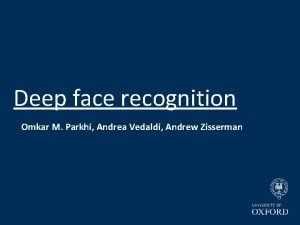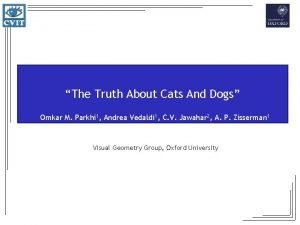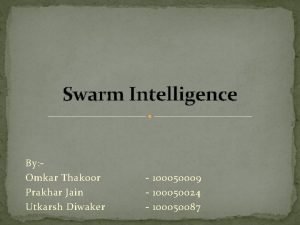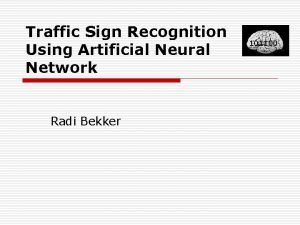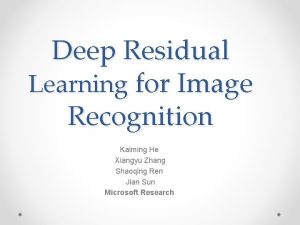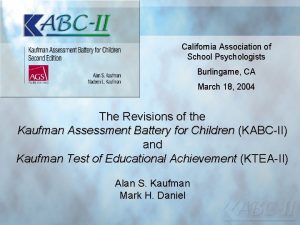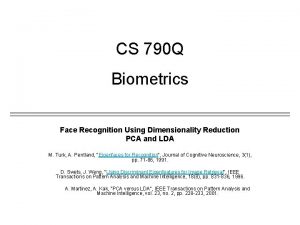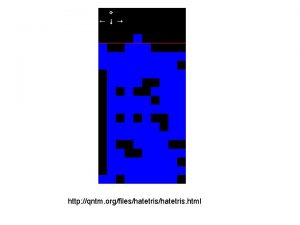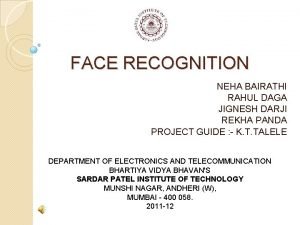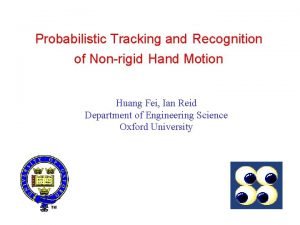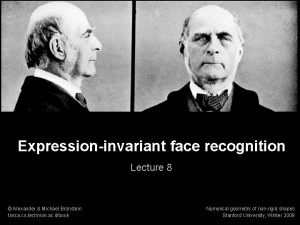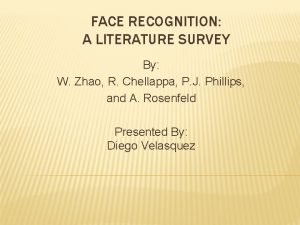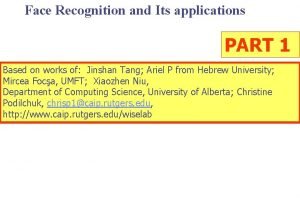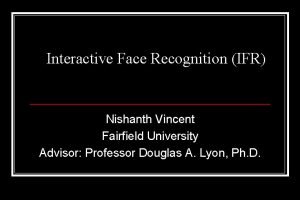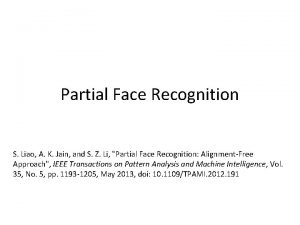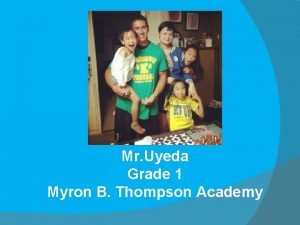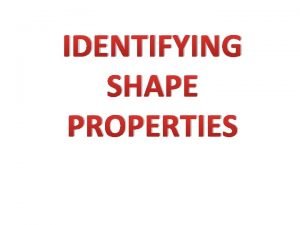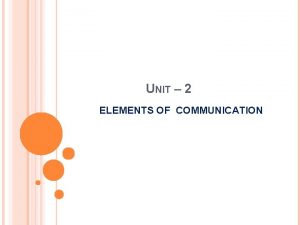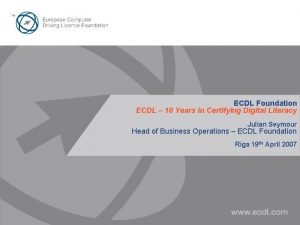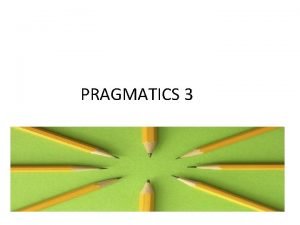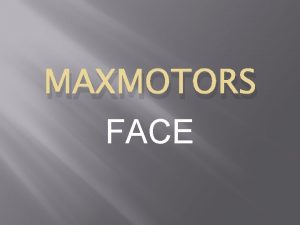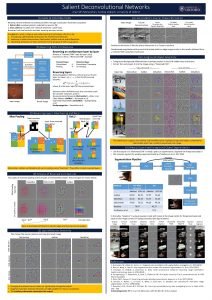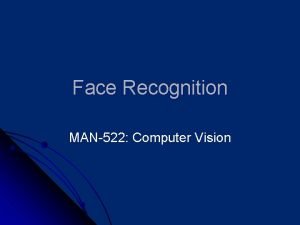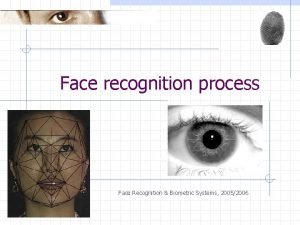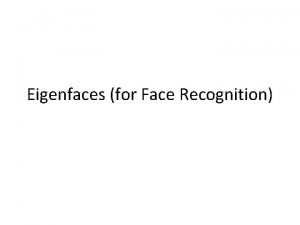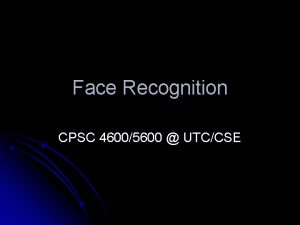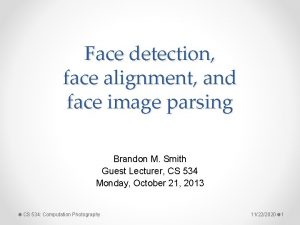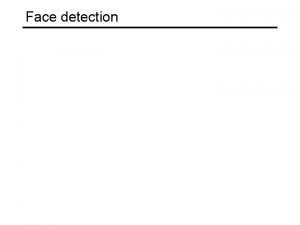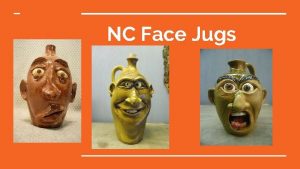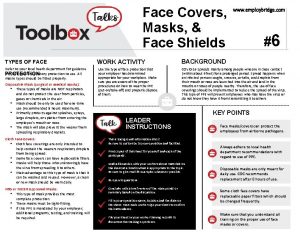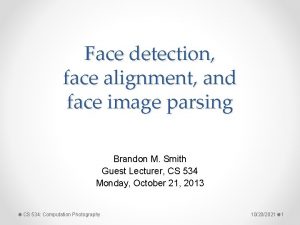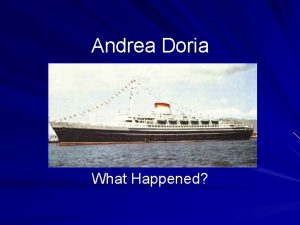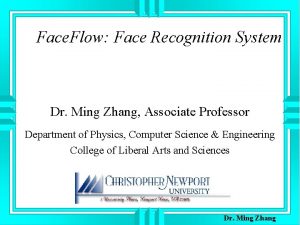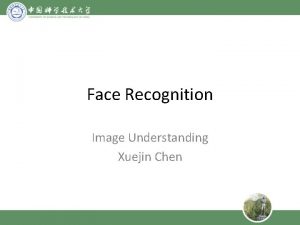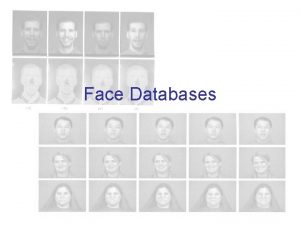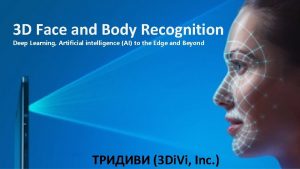Deep face recognition Omkar M Parkhi Andrea Vedaldi






























- Slides: 30

Deep face recognition Omkar M. Parkhi, Andrea Vedaldi, Andrew Zisserman

Key Questions • Can large scale datasets be built with minimal human intervention? Yes! • Can we propose a convolutional neural network which can compete with that of internet giants like Google and Facebook? Yes!

Achievements • New face dataset of 2. 6 Million Faces • State of the art results on You. Tube faces in the wild dataset • Comparable to the state of the art results on the Labeled faces in the wild dataset

Can large scale datasets be built with minimal human intervention?

Dataset Collection 1. Candidate list generation: Finding names of celebrities • Tap the knowledge on the web • 5000 identities Robert Downey Jr. Ashley Hamilton Barack Obama Allison Hannigan Amitabh Bacchan Vladimir Putin

Dataset Collection 2. Manual verification of celebrities: Finding Popular Celebrities • • • Collect representative images for each celebrity 200 images/identity Remove people with low representation on Google. Remove overlap with public benchmarks 2622 celebrities for the final dataset

Dataset Collection Popular Celebrity Robert Downey Jr.

Dataset Collection Not so popular celebrity Ashley Hamilton

Dataset Collection 2. Manual verification of celebrities: Finding Popular Celebrities • • • Collect representative images for each celebrity 200 images/identity Remove people with low representation on Google. Remove overlap with public benchmarks 2622 celebrities for the final dataset

Dataset Collection 3. Rank image sets • • 2000 images per identity Searching by appending keyword “actor” • • • Learning classifier using data obtained the previous step. c Ranking 2000 images and selecting top 1000 images Approx. 2. 6 Million images of 2622 celebrities

Dataset Collection 4. Near duplicate removal • VLAD descriptor based near duplicate removal 5. manual filtering • Curating the dataset further using manual checks No. Aim Mode # Persons # images /person Total # images Anno. effort 1 Candidate list generation Auto 5000 200 1, 000 - 2 Candidate list filtering Manual 2622 - - 4 days 3 Rank image sets Auto 2622 1000 2, 622, 000 - 4 Near duplicate removal Auto 2622 623 1, 635, 159 - 5 Manual filtering Manual 2622 375 982, 803 10 days

Dataset Collection Dataset Comparison No. Aim # Persons Total # images 1 Labeled Faces In the Wild 5, 749 13, 233 2 WDRef 2995 99, 773 3 Celeb Faces 10177 202, 599 4 Ours 2622 1, 635, 159 5 Facebook 4030 4. 4 M 6 Google 8 M 200 M

Dataset Collection Example Images From Our Dataset

Can we propose a convolutional neural network which can compete with that of internet giants like Google and Facebook etc. ?

Convolutional Neural Network image Conv-64 maxpool • The “Very Deep” Architecture Conv-128 • Conv-128 Different from previous architectures proposed for face recognition: • locally connected layers (Facebook) • inception (Google) maxpool Conv-256 maxpool Conv-512 • Network Details: • • • 3 x 3 Convolution Kernels (Very small) Conv. Stride 1 px. Relu non-linearity No local contrast normalisation 3 Fully connected layers Conv-512 maxpool Conv-512 maxpool fc-4096 Very Deep Convolutional Networks for large-Scale Image Recognition. K. Simonyan and A. Zisserman. fc-2622 Softmax

Convolutional Neural Network Training image Conv-64 maxpool Conv-128 • Mat. Conv. Net Tootlbox • Nvidia Cu. DNN bindings • Multi GPU Training (approx 3. 5 x speedup) • Nvidia Titan Black • 7 days of training Conv-128 maxpool Conv-256 maxpool Conv-512 • Random Gaussian Initialization • Stochastic Gradient Descent with back prop. • Accumulator Descent for large batch sizes • Batch Size: 256 • Incremental FC layer training Conv-512 maxpool Conv-512 • 2622 way multi class criterion (soft max) maxpool fc-4096 Matconvnet – convolutional neural networks for matlab. A Vedaldi and K. Lenc. Arxiv - 2014. fc-2622 Softmax

Convolutional Neural Network Training: Learning Task Specific Embedding • Learning embedding by minimizing triplet loss • Learning a projection from 4096 to 1024 dimensions • On line triplet formation at the beginning of each iteration • Fine tuned on target datasets • Only the projection layers learnt

Design Choices 1. Network configuration • Does increasing the depth improves performance? 1. Face alignment • Can the network be invariant to changes in the faces? 2. Task specific learning • What are the effects of task specific embedding learning on performance?

Labeled Faces In the Wild Dataset (LFW) • Face Verification: Given a pair of images specify whether they belong to the same person • 13 K images, 5. 7 K people • Standard benchmark in the community • Several test protocols depending upon availability of training data within and outside the dataset. [ G. Huang, M. Ramesh, T. Berg and E. Learned-Miller - Tech Report 07]

Effects of design choices (LFW Unrestricted Protocol) No. Network Config. Dataset Face Align Training Face Align Testing Embedding 100%-EER 1 A Curated No No No 92. 83 2 A Full No No No 95. 80 3 A Full No Yes No 96. 70 4 B Full No Yes No 97. 72 5 B Full Yes No 97. 07 6 D Full No Yes No 96. 60 7 B Full No Yes 99. 13

Comparison with the State of the Art (LFW Unrestricted Protocol) No. Method # Training Images # Networks Accuracy 1 Fisher Vector Faces - - 93. 10 2 Deep. Face 4 M 3 97. 35 3 Deep. Face Fusion 500 M 5 98. 37 4 Deep. ID-2, 3 Full 200 99. 47 5 Face. Net 200 M 1 98. 87 6 Face. Net+ Alignment 200 M 1 99. 63 7 VGG Face 2. 6 M 1 98. 95

You. Tube Faces Dataset (YTF) same different • Video Face Verification: Given a pair of videos specify whether they belong to the same person • 3425 videos, 1595 people • Standard benchmark in the community • Wide pose, expression and illumination variation [Wolf, Hassner, Moaz CVPR 2011]

Comparison with the State of the Art (YTF Unrestricted Protocol) No. Method # Training Images # Networks 100%-EER Accuracy 1 Video Fisher Vector Faces - - 87. 7 93. 10 2 Deep. Face 4 M 1 91. 4 4 Deep. ID-2, 2+, 3 200 - 93. 2 5 Face. Net + Alignment 200 M 1 - 95. 1 7 VGG Face 2. 6 M 1 97. 4 97. 3

Oxford Buffy Dataset Weakly supervised face classification • “Buffy The Vampire Slayer” • • Face tracks from 7 episodes of season 5. Both frontal and profile detections Weak supervision from transcript and subtitles Multi Class classification for every episode [Everingham et al. IVC 2009, Sivic et al. CVPR 2009]

Comparison with the State of the Art (Oxford Buffy Dataset) No. Method Mean AP 1 Sivic et. al (HOG + RBF SVM) 0. 81 2 Video Fisher Vector Faces (FV + Lin SVM) 0. 86 3 Ours (CNN + MIL SVM) 0. 95

Deep Face Dreams Inversion by maximizing class specific neuron responses Representative Image Neuron Inversion [Simonyan et al. NIPS 2014, Mahendran et al. CVPR 2015]

Deep Face Dreams Inversion by maximizing class specific neuron responses Representative Image Neuron Inversion [Simonyan et al. NIPS 2014, Mahendran et al. CVPR 2015]

Deep Face Dreams Inversion by maximizing class specific neuron responses Representative Image Neuron Inversion [Simonyan et al. NIPS 2014, Mahendran et al. CVPR 2015]

Deep Face Dreams Inversion by maximizing class specific neuron responses Representative Image Neuron Inversion [Simonyan et al. NIPS 2014, Mahendran et al. CVPR 2015]

Thank You!
 Omkar parkhi
Omkar parkhi Omkar the cat
Omkar the cat Omkar thakoor
Omkar thakoor Deep learning speech recognition
Deep learning speech recognition Traffic sign recognition deep learning
Traffic sign recognition deep learning He kaiming
He kaiming California association of school psychologists
California association of school psychologists Face recognition
Face recognition Face recognition
Face recognition Face recognition
Face recognition Face recognition
Face recognition Facial expression recognition
Facial expression recognition Face recognition
Face recognition Paul hrycewicz
Paul hrycewicz Sensation vs perception
Sensation vs perception Face recognition a literature survey
Face recognition a literature survey Clova face recognition
Clova face recognition Conclusion of face recognition
Conclusion of face recognition Face recognition
Face recognition Face recognition
Face recognition Face recognition literature review
Face recognition literature review O the deep deep love of jesus
O the deep deep love of jesus Deep asleep deep asleep it lies
Deep asleep deep asleep it lies Deep forest towards an alternative to deep neural networks
Deep forest towards an alternative to deep neural networks Face-to-face narrative examples
Face-to-face narrative examples Myron b thompson academy
Myron b thompson academy I have a flat face
I have a flat face Lesson 2 elements of communication
Lesson 2 elements of communication Ecdl foundation
Ecdl foundation Attributable silence
Attributable silence Example of alliteration in romeo and juliet act 1
Example of alliteration in romeo and juliet act 1
